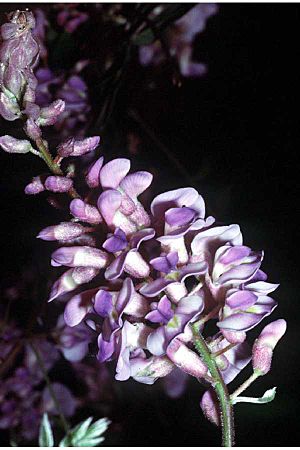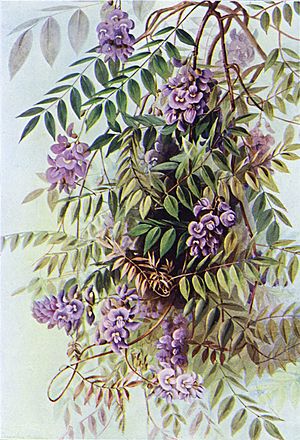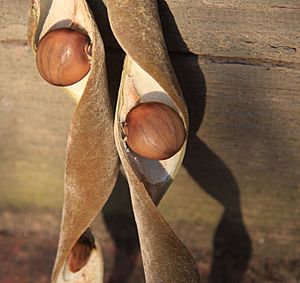American wisteria facts for kids
Quick facts for kids American wisteria |
|
|---|---|
 |
|
| Scientific classification | |
| Genus: |
Wisteria
|
| Species: |
frutescens
|
| Synonyms | |
|
|
Wisteria frutescens, often called American wisteria, is a climbing plant. It is a vine that loses its leaves in winter. This plant is a type of wisteria and belongs to the pea family, Fabaceae. You can find it growing naturally in wet forests and along stream banks. Its home is in the southeastern United States. This area stretches from Virginia to Texas, and even north to Iowa, Michigan, and New York.
Contents
About American Wisteria
The famous scientist Carl Linnaeus was the first to describe Wisteria frutescens.
There is a special type of American wisteria called Kentucky wisteria. It is found in the southeastern United States, including Kentucky. Sometimes, people consider it a separate species.
What Does American Wisteria Look Like?
American wisteria is a strong climber. It can grow up to 15 meters (about 50 feet) long. It wraps its stems around supports in a clockwise direction. In late spring or early summer, it grows many clusters of blue-purple flowers. Each flower is about 2 centimeters (0.8 inches) wide. These flower clusters are usually 5 to 15 centimeters (2 to 6 inches) long. These are the smallest flower clusters of all wisteria plants.
The leaves are shiny and dark green. They are made up of 9 to 15 smaller oval-shaped leaflets. Each leaflet is about 2 to 6 centimeters (0.8 to 2.4 inches) long. The whole leaf can be 10 to 30 centimeters (4 to 12 inches) long.
After the flowers, the plant grows bean-like seed pods. These pods are 5 to 10 centimeters (2 to 4 inches) long. They start out fuzzy and greenish-tan. When they dry, they become smooth and shiny brown. The seeds inside are large and brown.
American wisteria likes moist soil. It can grow in shady spots, but it needs some sun to produce flowers. It grows best in areas with moderate winters and warm summers.
How is it Different from Other Wisterias?
American wisteria has some unique features compared to wisterias from Asia. It does not grow as tall, reaching only about two-thirds the height. Its flower clusters are shorter, about half the length of Asian types. The flowers also do not have a scent. The seed pods are smooth when they are mature, not velvety.
Kentucky wisteria is very similar to American wisteria. However, Kentucky wisteria sometimes has a fragrance.
Wisteria in Nature
Several types of butterflies and moths use American wisteria. Their young, called larvae, feed on the plant. These include the long-tailed skipper, silver-spotted skipper, marine blue, and zarucco duskywing butterflies. The Cuphodes wisteriae moth also uses it.
Keeping Wisteria Healthy
American wisteria usually does not have many problems with pests or diseases. However, common garden pests can sometimes bother it. These include tiny insects like aphids, leaf miners, and Japanese beetles.
Some beetles, like longhorn beetles, can be a bigger problem. They bore into the woody stems of young or unhealthy wisteria plants. This can stop water and nutrients from moving through the plant. It can also let diseases, like rot, get inside, which might cause the plant to die.
Sometimes, a type of bacteria found in soil can infect wisteria. This can cause unusual growths or swellings on the roots or stems.
Wisteria can also be affected by tiny worms called Root-knot nematodes. These worms can damage the roots. A fungus called Texas root rot can also harm the roots. When roots are damaged, the plant cannot absorb water, which makes it wilt and eventually die.
Some other wisteria species can get diseases like powdery mildew or cankers. Scientists are still studying if American wisteria can get these same diseases.
Important Safety Information
All parts of the Wisteria plant contain a substance called Wisterin. This includes the bark, branches, pods, roots, and seeds. There is some discussion about whether the flowers are also harmful.
Eating even one or two seed pods can make you sick. Symptoms include an upset stomach, feeling sick, throwing up a lot, stomach pain, and diarrhea. In serious cases, this can lead to dehydration and weakness. Usually, people feel better within 24 hours.
The amount of harmful substances can be different in various parts of the plant. It can also change during different seasons. Because of this, it is very important to never eat any part of the wisteria plant.
Wisteria seeds also contain a substance called Canavanine. This helps protect the plant from animals that might try to eat it.
Images for kids
See Also





